What Is Chamois Cream and How to Use It? Complete Guide With Recommended Products
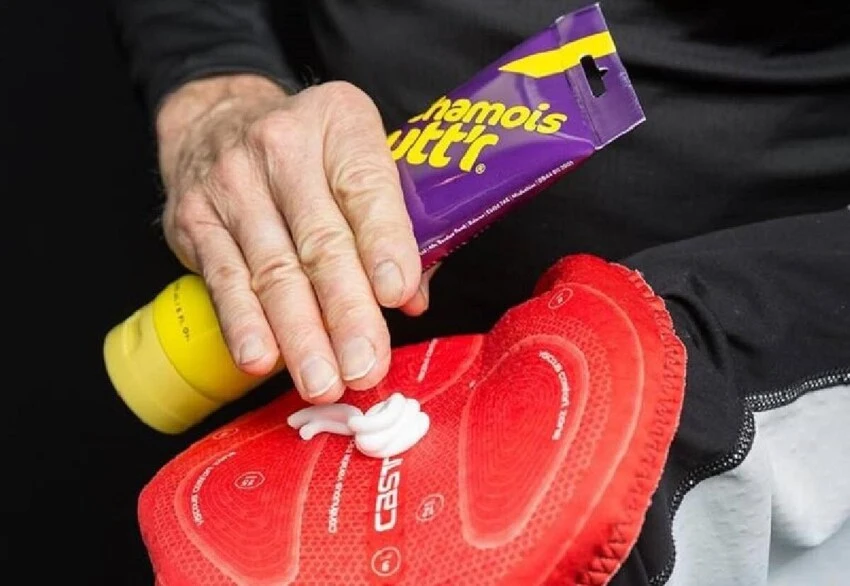
If you’ve ever locked eyes with a cyclist in lycra lathering thick cream on their underside, you might have wondered what on earth was happening. The answer is quite simple—they were applying chamois cream.
Chamois cream is used to minimize friction between your skin and the bib pad (aka chamois), preventing chafing and saddle sores. It’s used on long rides, such as centuries, bikepacking, and randonneuring, when you need to spend hours in the saddle.
But not everyone likes it and believes in its magic. Then, what should you do?
In this article, we’ll tell you more about how, why, and when to use chamois cream, and recommend a few products that we like, so you can make an informed decision.
What Is Chamois Cream?
To understand what chamois cream is, let’s first clarify what a chamois (pronounced ‘shammy’) is and why it’s used.
A chamois is a padded seat insert sewn into the back of bib shorts and tights, providing cushioning between the bike saddle and your underside.
The chamois originated in France and was originally made from the soft leather of Chamois alpine goats, hence the name. Over time, this leather would become hard and rough, requiring hydration and softening using chamois cream.
Today, modern bibs feature synthetic, soft, antibacterial pads, and chamois cream is typically applied directly to the skin rather than the chamois.
Many modern creams also offer cooling effects, along with antibacterial and antifungal properties to prevent infections during long rides.
Best Chamois Creams for Cycling
1. Paceline Chamois Butt’r Original Anti-Chafe Cream
- Price: $20
- Container: Tube, 8 fl. oz.
- Menthol: No
- Antibacterial: Yes
- For: Unisex
The Paceline Chamois Butt’r Original is one of the best chamois creams for cyclists out there, known for its simple formula and great value for the money.
While this product is available in different sizes and container types, the one we chose comes in an 8 fl. oz. tube, which will last you a long time. However, it’s not very practical to carry with you on long rides, even though it can easily fit in your back jersey pocket.
The Paceline Chamois Butt’r doesn’t have menthol, so it’s suitable for both men and women who dislike the cooling sensation. It’s also antibacterial, meaning it will prevent infections and irritation if skin abrasions occur.
According to the manufacturer, you can apply it to your skin or directly to the chamois, though we recommend using it on your body. After the ride, it can be easily washed off using water and soap.
2. DZ Nuts Pro Men’s Chamois Cream for Cycling
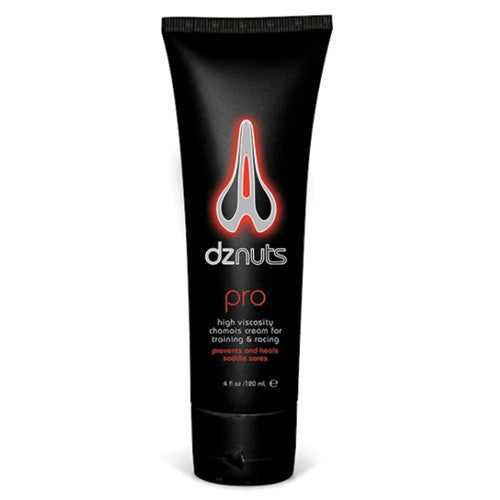
- Price: $24
- Container: Tube, 4 fl. oz.
- Menthol: Yes
- Antibacterial: Yes
- For: Men
According to the company, the DZ Nuts Pro chamois cream was created for David Zabriskie, a former professional US road cyclist, so he could train for longer without dealing with saddle sores.
This cream boasts anti-fungal and anti-bacterial properties, preventing bacterial and fungal infections, which is especially important if you ride in humid conditions. It’s also made from plant-based, natural ingredients, so it’s suitable for vegans.
The DZ Nuts Pro cream comes with menthol and provides a cooling effect, which may not be up everyone’s alley. The brand also makes a women-specific version of this cream that comes free of menthol and has a slightly altered pH value more suitable for women.
This 4 fl. oz. package is pricey compared to some other options on the market, but it’s easy to carry with you in a frame bag or jersey pocket.
Buy from Jenson USA Buy from Amazon
3. Muc-Off Men’s Chamois Cream for Cyclists

- Price: $20
- Container: Tube, 8.4 fl. oz.
- Menthol: Yes
- Antibacterial: Yes
- For: Men
Muc-Off is a brand famous for chain lubricants and bike cleaning supplies, but it also makes bicycle chamois creams.
This version is intended for men because it has a cooling, menthol effect, but a women’s version is also available. In addition to menthol, this Muc-Off product is enriched with aloe, witch hazel, shea butter, and sunflower oil, designed to hydrate and soothe your skin.
Just like their chain lubricants, this bike chamois cream has a long-lasting formula designed to work well in demanding conditions, so it’s recommended for riding in wet or humid conditions.
It’s also antibacterial, so it will prevent infections in case chafing has already caused tiny scrapes on your skin. However, you don’t need to let that happen as it comes in a tube, so you can double-dip as many times as necessary.
4. Assos Chamois Cream
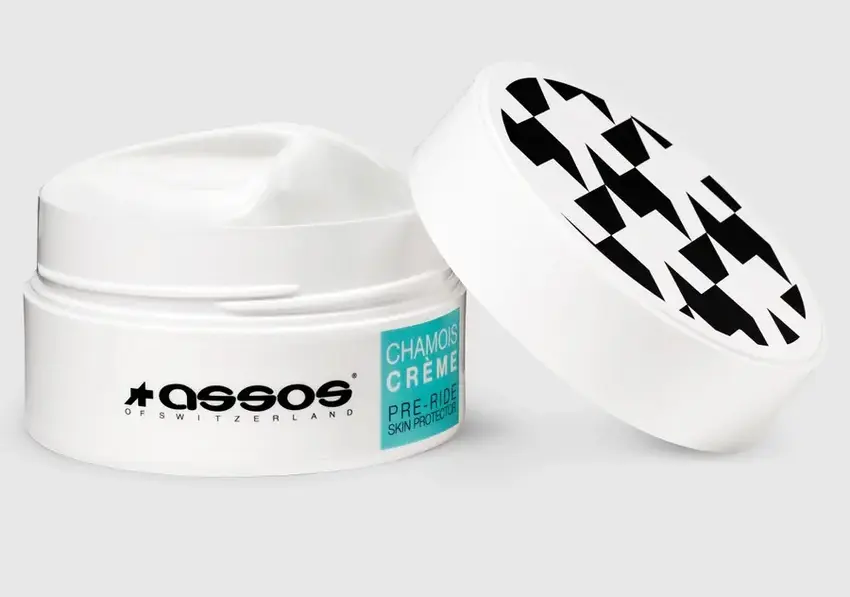
- Price: Check on Amazon
- Container: Pot
- Menthol: Yes (Mild)
- Antibacterial: Yes
- For: Unisex
The Assos chamois cream is a tried-and-true product that comes at a premium compared to other choices out there.
This product boasts antibacterial properties and a mild cooling agent that will numb your skin and decrease unpleasant sensations.
The cream is available in a pot, in two sizes—6.76 fl. oz. and 2.54 fl. oz. The larger container provides more value, but the smaller option is easier to carry around.
Unfortunately, double-dipping is not practical due to the container type, but the good news is that a small amount of the Assos cream usually goes a long way.
5. Squirrel’s Nut Butter
- Price: $24.95
- Container: Tub
- Menthol: No
- Antibacterial: No
- For: Unisex
The Squirrel’s Nut Butter is a unique anti-chafe cream that can be used by cyclists and other athletes to prevent chafing and blisters.
This cream features coconut oil and cocoa butter to create a long-lasting barrier on the surface of your skin and prevent irritation. You can apply it to any part of your body, but keep in mind that it might stain your clothes, depending on the color and the material.
The list of ingredients also includes beeswax, which helps the slick barrier last longer and keep your skin moisturized and chafe-free. All ingredients are natural, so you can use it regularly without worrying about any toxic chemicals.
Also Worth Considering
Here are a few more options worth considering when choosing the best chamois cream:
- Chamois Butt’R GoStik Anti-Chafe: The Chamois Butt’R GoStik offers easy, mess-free application with its convenient stick format. It provides effective anti-chafe protection without needing direct hand contact.
- Muc-Off Womens Luxury CC: One of the best chamois creams for female cyclists that includes soothing aloe vera, along with an antibacterial effect. It delivers comfort and protection tailored to women.
- Paceline Eurostyle Chamois Butt’R Jar: This jar version of Paceline’s chamois cream features a similar formula to the original but with a subtle menthol component for added comfort. Ideal for pre-ride application due to its larger quantity.
- Gooch Guard: Gooch Guard Chamois Cream offers all-natural ingredients and a formula that works in the heat, making it perfect for challenging riding conditions. Its unique formula helps prevent irritation and keep skin healthy.
Why Use Chamois Cream?
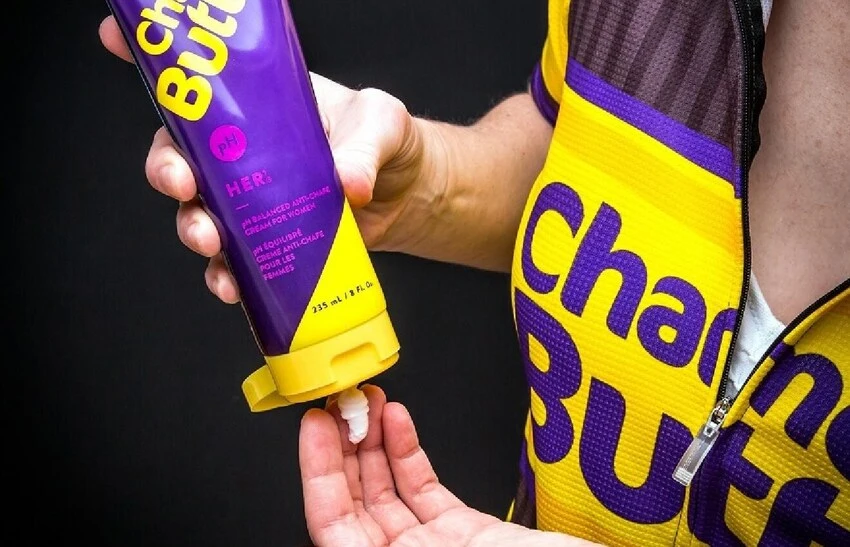
The biggest reason for using chamois cream is to prevent chafing, reduce friction, and avoid saddle sores.
On long rides, the friction between your skin and cycling pad, coupled with the pressure from the saddle, can lead to swelling and chafing.
If ignored, this can lead to abscesses and saddle sores, which means you’ll need to take time off the bike to heal.
Many products also contain menthol and provide a cooling effect, but not everyone likes it. Some women find this uncomfortable if it comes into contact with their genitalia.
Some products are also advertised with antibacterial and antifungal properties, which can be important if saddle sores appear, as they can get infected from the combination of sweat, dirt, and dust.
When to Use Chamois Cream?
Chamois cream should be used on long rides that require you to spend hours in the saddle. Most cyclists don’t apply it on rides that are under an hour because there’s not enough time for chafing or saddle sores to appear.
If you’re heading out on a century ride, a randonneuring event, or you’re planning to spend several days in the saddle touring on a bikepacking bike, we recommend applying it in areas that are prone to chafing.
Still, not everyone uses chamois cream—some cyclists do back-to-back, day-long rides and never need it. But if you have experience with painful saddle sores, it’s best to give it a try and see whether or not it works for you.
How to Apply Chamois Cream?
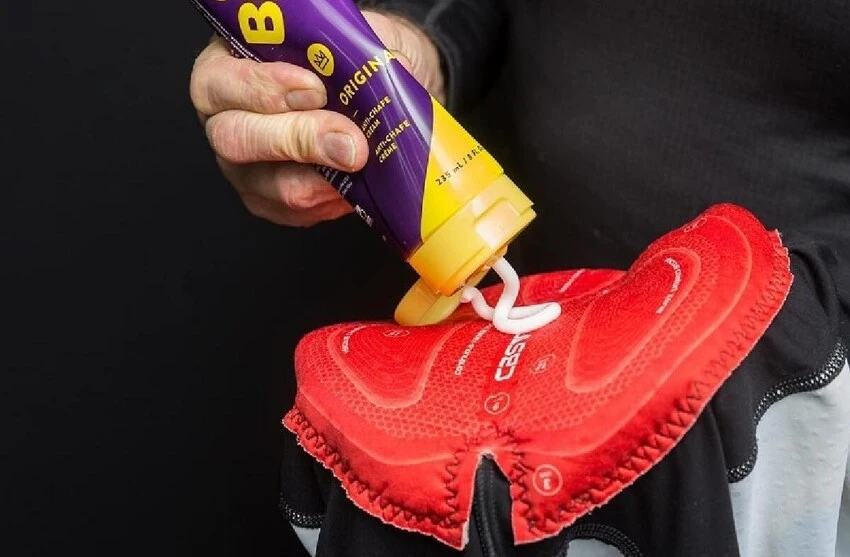
In the early days of cycling, when bib shorts and tights featured leather pads, chamois cream was applied directly to the pad itself. Nowadays, most cyclists apply it directly to their skin, which allows more precision.
If you’re new to using chamois cream, or you’re unsure whether you’re using it correctly, here are a few easy steps to follow:
- Scoop the cream: Take a one- or two-fingered scoop of cream out of a pot or tub. The exact amount will depend on your preference and the duration of your ride.
- Apply to key areas: Rub it directly onto your skin in areas that come into contact with the saddle, including your buttocks, sit bones, and around the groin area, where chafing may occur.
- Don’t double dip: If your cream comes in a pot, don’t ‘double dip’ with the same hand you used the first time, for hygiene reasons. If you want to reapply the cream, make sure to wash your hands first.
- For women: Women should avoid applying chamois cream around the crotch area to prevent contact with genitalia, as this could cause infection or painful sensations, especially if the cream contains menthol.
Personally, one application lasts me 4–5 hours in the saddle, but you might need some trial and error to figure out what works best for you.
It’s best to apply chamois cream just before you start your ride, not after the sores have already formed. On longer rides, it’s advised to reapply the cream every 3–5 hours, though this can vary based on individual needs.
What to Consider When Buying Chamois Cream?
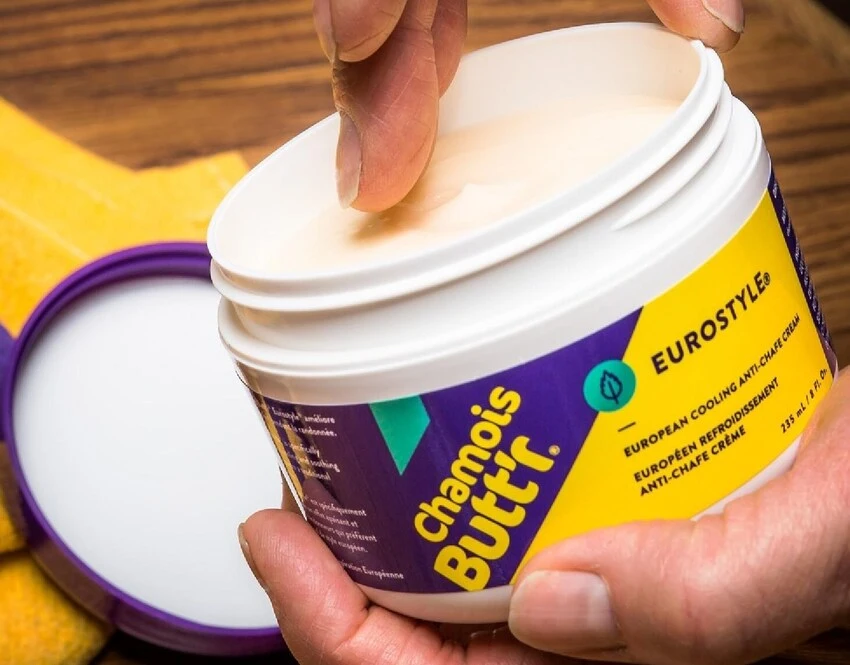
The chamois cream market is quite straightforward, so there’s not much to worry about or many ways to go wrong. The three things you should think about include:
- Container type: pot or tube
- To menthol or not
- Women-specific creams
The first thing to consider is the type of container—either a pot or a tube. I personally prefer tubes because you can double-dip without worrying about contaminating the cream, though pots can be easier to carry. Chamois creams also come in various sizes, so if you’re planning a multiday ride, you might want to choose a smaller container for convenience. To save money, many riders purchase large, economy-sized containers and then transfer a smaller amount into a portable container for rides.
The second consideration is whether you want a cream with menthol. While menthol can provide a soothing, numbing effect after hours in the saddle, not everyone is fond of it. I find it to be uncomfortable on cold days, and it can sting if it ends up in the wrong places.
Lastly, some brands offer women-specific creams with a lower pH to minimize the risk of vaginal irritation and infection. These creams are also usually menthol-free, as there’s a higher chance it can come into contact with sensitive areas and cause discomfort, due to women’s anatomy.
Frequently Asked Questions
Can I Use Vaseline or Sudocrem as Chamois Cream?
Vaseline and Sudocrem can reduce friction, but they lack antibacterial properties and may not allow your skin to breathe, making things worse. While Sudocrem offers some protection against friction, it’s not as effective in preventing chafing during long rides. Chamois creams are specifically formulated to prevent both chafing and infections.
How long does chamois cream last?
One application of chamois cream typically lasts 4–5 hours, but this can vary based on several factors. On rainy, hot, or humid days, sweat and moisture may cause the cream to wear off faster, requiring more frequent application. The cream’s formula also plays a role, as best chamois creams offer longer protection and lubrication.
Where do men apply chamois cream?
Men apply chamois cream to areas prone to chafing, including the inner thighs, buttocks, and the saddle contact points. Some also apply it on their nipples to prevent chafing caused by bib straps. This helps reduce friction between the skin and cycling bibs, preventing discomfort and irritation during rides.
How often should you reapply chamois cream?
Reapply chamois creams every 3–4 hours on average, to ensure you prevent chafing and saddle sores. When riding in humid or wet conditions, reapply as needed to maintain lubrication and decrease friction. It’s best to listen to your body and monitor for any signs of discomfort and irritation to determine when a new application is needed.
Do you put chamois cream on chamois or skin?
Chamois cream should be applied directly to the skin, in areas prone to chafing, such as the inner thighs, buttocks, and around the saddle bones. In the past, cyclists used leather seat pads and applied the cream directly to the pad. But this method can reduce the cream’s effectiveness with modern pads, as they are more absorbent.



